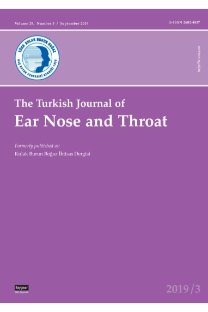Larenjektomi ve izleyen radyoterapinin tiroit fonksiyonları üzerine etkisi
Kombine tedavi, larenjeal neoplazmlar/cerrahi/radyoterapi, hipotiroidi/etyoloji, larenjektomi, radyoterapi/yan etki, tiroit bezi/immünoloji/radyasyon etkisi, tiroitfonksiyon testleri, tiroidektomi/yan etki
The effect of laryngectomy and postoperative radiotheraphy on thyroid gland functions
Combined modality therapy, laryngeal neoplasms/ surgery/radiotherapy, hypothyroidism/etiology, laryngectomy, radiotherapy/adverse effects, thyroid gland/immunology/radiation effect, thyroid function tests, thyroidectomy/adverse effects,
___
- Brennan JA, Meyers AD, Jafek BW. The intraoperative management of the thyroid gland during laryngecto- my. Laryngoscope 1991;101:929-34.
- Tami TA, Gomez P, Parker GS, Gupta MB, Frassica DA. Thyroid dysfunction after radiation therapy in head and neck cancer patients. Am J Otolaryngol 1992;13: 357-62.
- Fagan JJ, Kaye PV. Management of the thyroid gland with laryngectomy for cT3 glottic carcinomas. Clin Otolaryngol 1997;22:7-12.
- Uzunalioğlu A. Hipotiroidi. In: Koloğlu S, editör. Te- mel ve klinik endokrinoloji. 1. baskı. Ankara: Kozan Ofset Yayıncılık; 1996. s. 243-6.
- Alexander MV, Zajtchuk JT, Henderson RL. H y p o t h y roidism and wound healing: occurrence after head and neck radiation and surg e r y. Arch Otolaryngol 1 9 8 2 ; 1 0 8 : 2 8 9 - 9 1 .
- Talmi YP, Finkelstein Y, Zohar Y. Pharyngeal fistulas in postoperative hypothyroid patients. Ann Otol Rhinol Laryngol 1989;98:267-8.
- Silver CE, Rubin JS (editors). Atlas of head and neck s u rg e r y. 2nd ed. Edinburg: Churchill Livingstone; 1999.
- Biel MA, Maisel RH. Indications for performing hemithyroidectomy for tumors requiring total laryn- gectomy. Am J Surg 1985;150:435-9.
- Dadas B, Uslu B, Cakir B, Ozdogan HC, Calis AB, Turgut S. Intraoperative management of the thyroid gland in laryngeal cancer surgery. J Otolaryngol 2001; 30:179-83.
- fierbetçi E, Çölhan İ, Yazıcıoğlu E, Delioğlu K, Öz- türk S. Lare n g o f a rengeal kanser cerrahisinde tiro i d bezine yaklaflım. Kulak Burun Bogaz Ihtis Derg 1991; 2 : 5 9 - 6 1.
- Gilbert RW, Cullen RJ, van Nostrand AW, Bryce DP, Harwood AR. Prognostic significance of thyroid gland involvement in laryngeal carcinoma. Arch Otolaryngol Head Neck Surg 1986;11 2 : 8 5 6 - 9 .
- Vrabec DP, Heff ron TJ. Hypothyroidism following treatment for head and neck cancer. Ann Otol Rhinol Laryngol 1981;90:449-53.
- Buisset E, Leclerc L, Lefebvre JL, Stern J, Ton-Van J, Gosselin P, et al. Hypothyroidism following combined treatment for hypopharyngeal and laryngeal carcino- ma. Am J Surg 1991;162:345-7.
- Liening DA, Duncan NO, Blakeslee DB, Smith DB. H y p o t h y roidism following radiotherapy for head and neck cancer. Otolaryngol Head Neck Surg 1990; 1 0 3 : 1 0 - 3 .
- Posner MR, Ervin TJ, Miller D, Fabian RL, Norris CM Jr, Weichselbaum RR, et al. Incidence of hypothy- roidism following multimodality treatment for advanced squamous cell cancer of the head and neck. Laryngoscope 1984;94:451-4.
- Grande C. Hypothyroidism following radiotherapy for head and neck cancer: multivariate analysis of risk factors. Radiother Oncol 1992;25:31-6.
- Tell R, Sjodin H, Lundell G, Lewin F, Lewensohn R. Hypothyroidism after external radiotherapy for head and neck cancer. Int J Radiat Oncol Biol Phys 1997; 39:303-8.
- Akalın S, Sezgin Ö. Hipotiroidizm. In: İflgör A, editör. Ti roit hastalıkları ve cerrahisi. 1. baskı. İstanbul: Avrupa Tıp Kitapçılık; 2000. s. 253-76.
- ISSN: 2602-4837
- Yayın Aralığı: 4
- Başlangıç: 1991
- Yayıncı: İstanbul Üniversitesi
Servikal osteofite bağlı disfaji: Olgu sunumu
Sündüs GENCAY, Haluk YAVUZ, Cüneyt YILMAZER
Subtotal larenks cerrahisinde Delphian lenf nodunun önemi
Sinan KOCATÜRK, Şemsettin OKUYUCU, Ünsal ERKAM, Fulya KÖYBAŞIOĞLU, Ayper KAÇAR
Larenjektomi ve izleyen radyoterapinin tiroit fonksiyonları üzerine etkisi
Uğur ÇINAR, Özgür YİĞİT, Seyhan ALKAN, Berna USLU COŞKUN, Ebru TOPUZ, Özlem ÜNSAL, Gökhan AKGÜL, Burhan DADAŞ
